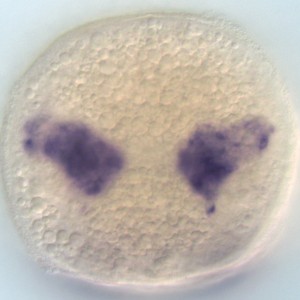C. teleta is a powerful system for studying developmental biology in an evolutionary context. A key step during  central nervous system development in arthropods and vertebrates is specifying the fate of neural precursor cells (NPCs), which generate the brain and nerve cord. Based on previous work, the cellular mechanisms of C. teleta brain development appear similar to those found in the development of the arthropod CNS. However, preliminary functional analyses of a proneural homolog in C. teleta (CapI-ash1) suggest a function that is more similar to proneural gene function during vertebrate neurogenesis. My lab employs several approaches to characterize the cellular and molecular aspects driving NPC fate specification during central nervous system development in C. teleta, including include high resolution imaging, gene expression analysis, functional analysis, and bioinformatics approaches, which are facilitated by a sequenced (8x coverage) C. teleta genome.
central nervous system development in arthropods and vertebrates is specifying the fate of neural precursor cells (NPCs), which generate the brain and nerve cord. Based on previous work, the cellular mechanisms of C. teleta brain development appear similar to those found in the development of the arthropod CNS. However, preliminary functional analyses of a proneural homolog in C. teleta (CapI-ash1) suggest a function that is more similar to proneural gene function during vertebrate neurogenesis. My lab employs several approaches to characterize the cellular and molecular aspects driving NPC fate specification during central nervous system development in C. teleta, including include high resolution imaging, gene expression analysis, functional analysis, and bioinformatics approaches, which are facilitated by a sequenced (8x coverage) C. teleta genome.
To further refine our model of brain development in C. teleta, we are currently developing methods for characterizing NPC behavior in real time, which will be combined with misexpression of proteins in the anterior ectoderm and functional analyses of neurogenic candidates. These techniques will be used to address questions such as whether or not a single NPC undergoes a stem-cell like mode of division in the surface to generate multiple neurons, or if NPCs undergo any additional divisions after they are internalized. Furthermore, these techniques can be combined with functional analyses to determine patterns of cell ingression, proliferation, and NPC fate specification in treated animals.


